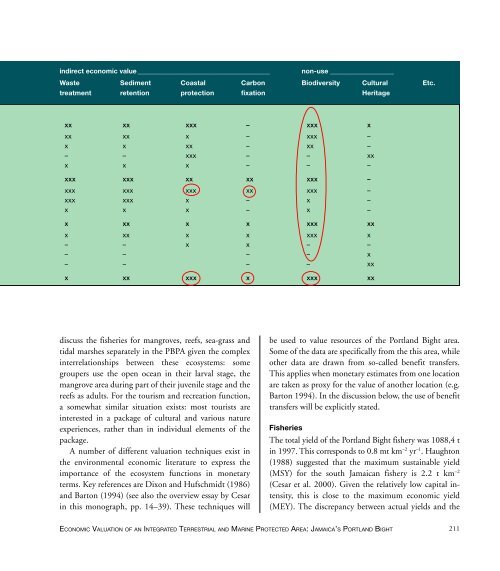You also want an ePaper? Increase the reach of your titles
YUMPU automatically turns print PDFs into web optimized ePapers that Google loves.
indirect economic value _______________________________________ non-use ___________________<br />
Waste Sediment Coastal Carbon Biodiversity Cultural Etc.<br />
treatment retention protection fixation Heritage<br />
xx xx xxx – xxx x<br />
xx xx x – xxx –<br />
x x xx – xx –<br />
– – xxx – – xx<br />
x x x – – –<br />
xxx xxx xx xx xxx –<br />
xxx xxx xxx xx xxx –<br />
xxx xxx x – x –<br />
x x x – x –<br />
x xx x x xxx xx<br />
x xx x x xxx x<br />
– – x x – –<br />
– – – – x<br />
– – – – xx<br />
x xx xxx x xxx xx<br />
discuss the fisheries for mangroves, reefs, sea-grass and<br />
tidal marshes separately in the PBPA given the complex<br />
interrelationships between these ecosystems: some<br />
groupers use the open ocean in their larval stage, the<br />
mangrove area during part <strong>of</strong> their juvenile stage and the<br />
reefs as adults. For the tourism and recreation function,<br />
a somewhat similar situation exists: most tourists are<br />
interested in a package <strong>of</strong> cultural and various nature<br />
experiences, rather than in individual elements <strong>of</strong> the<br />
package.<br />
A number <strong>of</strong> different valuation techniques exist in<br />
the environmental economic literature to express the<br />
importance <strong>of</strong> the ecosystem functions in monetary<br />
terms. Key references are Dixon and Hufschmidt (1986)<br />
and Barton (1994) (see also the overview essay by Cesar<br />
in this monograph, pp. 14–39). These techniques will<br />
be used to value resources <strong>of</strong> the Portland Bight area.<br />
Some <strong>of</strong> the data are specifically from the this area, while<br />
other data are drawn from so-called benefit transfers.<br />
This applies when monetary estimates from one location<br />
are taken as proxy for the value <strong>of</strong> another location (e.g.<br />
Barton 1994). In the discussion below, the use <strong>of</strong> benefit<br />
transfers will be explicitly stated.<br />
Fisheries<br />
The total yield <strong>of</strong> the Portland Bight fishery was 1088,4 t<br />
in 1997. This corresponds to 0.8 mt km –2 yr –1 . Haughton<br />
(1988) suggested that the maximum sustainable yield<br />
(MSY) for the south Jamaican fishery is 2.2 t km –2<br />
(Cesar et al. 2000). Given the relatively low capital intensity,<br />
this is close to the maximum economic yield<br />
(MEY). The discrepancy between actual yields and the<br />
ECONOMIC VALUATION OF AN INTEGRATED TERRESTRIAL AND MARINE PROTECTED AREA: JAMAICA’S PORTLAND BIGHT<br />
211


















